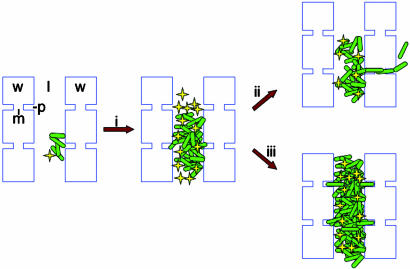Fig. 7.
Model of X. fastidiosa movement in the plant xylem. Small colonies of cells (green rods) attach to the xylem wall (w) and grow into larger colonies (i). These larger colonies likely impede xylem sap flow, which carries fresh nutrients, through the vessel lumen (l) while accumulating DSF (yellow stars). In most crowded vessels, cells escape through the bordered pits (p) to new adjacent vessels (ii) after the bordered pit membrane (m) is breached by DSF-induced degradative enzymes. In a few cases, cells may be unable to get through the membrane, perhaps because neighboring vessels are embolized or because pit membranes are resistant to destruction, and vessel plugging and disease occurs (iii). In the rpfF mutant, the lack of DSF production may cause crowded vessels to become plugged more frequently (iii). In a few cases, rpfF mutant cells must be able to gain access to adjacent vessels through preexisting openings or broken membranes (ii).

